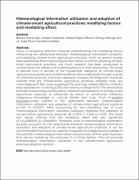| dc.contributor.author | Nantongo, Beckie | |
| dc.contributor.author | Ssekandi, Joseph | |
| dc.contributor.author | Ngom, Ablaye | |
| dc.contributor.author | Dieng, Birane | |
| dc.contributor.author | Diouf, Ndongo | |
| dc.contributor.author | Diouf, Jules | |
| dc.contributor.author | Noba, Kandioura | |
| dc.date.accessioned | 2024-04-02T10:19:18Z | |
| dc.date.available | 2024-04-02T10:19:18Z | |
| dc.date.issued | 2023-04-14 | |
| dc.identifier.other | https://doi.org/10.1016/j.envdev.2023.100857 | |
| dc.identifier.uri | http://hdl.handle.net/20.500.12280/3082 | |
| dc.description.abstract | There is increasing attention towards understanding the modifying factors influencing the relationship between meteorological information utilization and adopting climate-smart agricultural practices. Much as several studies have established that meteorological information is vital for adopting climate-smart agricultural practices, not much research has been conducted to contextualize the influence of modifying factors in that relationship. The study is derived from a sample of 341 households. Adoption of climate-smart agricultural practices and modifying effects were understood through a series of univariate, bivariant, and linear regression analyses. Findings from the study indicate that the climate-smart agriculture practices adopted most are; intercropping (71.8%), cover cropping (71%), and crop rotation (69.5%), while the least adopted are mulching (2.3%) and minimum tillage (4.1%). The relationship between meteorological information utilization and adoption of climate-smart agricultural practices is influenced by peers’ or community influence, indigenous knowledge or cultural beliefs, and trust. Trust in weather forecasts scored highest in the relationship between meteorological information utilization and adoption of climate-smart agricultural practices (x2=0.01, P = 0.002**). After accounting for the mediating role of trust, meteorological information utilization positively impacted the adoption of climate-smart agricultural practices (B = 0.376, t = 2.045, p < 0.05). The Sobel test results indicate that the mediation effect was also significant (Z = 6.45369270, p < 0.000001). Therefore, trust in meteorological information partially accounts for the relationship between meteorological information utilization and adoption of climate-smart agricultural practices. It can be recommended that there is a need for integration of indigenous knowledge in the scientific meteorological information and provision of finer grain forecasts that can be trusted by the end-users in a timely fashion. This will promote meteorological information utilization in the climate-smart agricultural practices adoption decision. | en_US |
| dc.language.iso | en | en_US |
| dc.publisher | Science Direct - Elsevier | en_US |
| dc.relation.ispartofseries | Environmental Development;Volume 46, June 2023, 100857 | |
| dc.subject | Meteorological information | en_US |
| dc.subject | Climate-smart agricultural practices | en_US |
| dc.subject | Intercropping | en_US |
| dc.subject | Cover cropping | en_US |
| dc.subject | Crop rotation | en_US |
| dc.subject | Mulching | en_US |
| dc.subject | Minimum tillage | en_US |
| dc.title | Meteorological information utilization and adoption of climate-smart agricultural practices; modifying factors and mediating effect | en_US |
| dc.type | Article | en_US |


